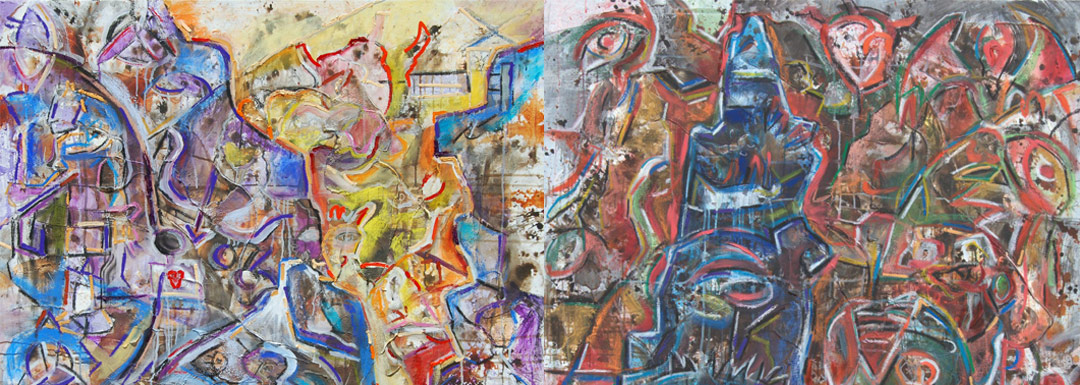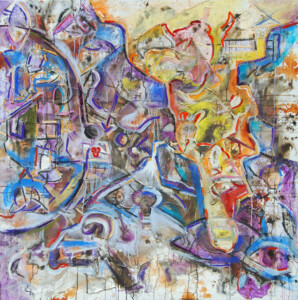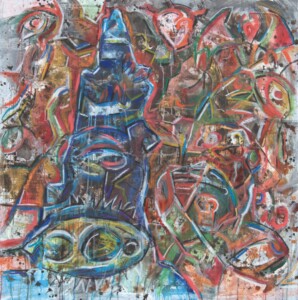The time I explored Dadaism and Italian Futurist art ironically – aka Absurdism vs Industrialization in Art.
I want to tell you about the time I explored Dadaism and Italian Futurist art ironically. I created two paintings at the time, one titled “Dada Lovecats” and “Futurist Pompeii.” These paintings are actually very personal and capture a specific moment in time, as any good artworks do. The allusion to Dadaism and Futurism in the title isn’t entirely direct.
History of the Dada Art movement
The Dada art movement emerged in Europe in the early 20th century as a response to the devastation and disillusionment brought on by World War I. It was a radical and subversive movement that rejected traditional artistic conventions and sought to challenge the very foundations of art itself.
How Dada got started
The origins of Dada can be traced back to the Cabaret Voltaire, a nightclub in Zurich, Switzerland, that was founded in 1916 by a group of artists and intellectuals including Hugo Ball, Tristan Tzara, and Jean Arp. The Cabaret Voltaire was a space for experimental performance, poetry, and visual art, and it quickly became a hub for the emerging Dada movement.
Marcel Duchamp
One of the most famous and influential Dada artists was Marcel Duchamp, a French-American artist who is widely considered one of the most important figures in 20th-century art. Duchamp’s work challenged traditional notions of art and pushed the boundaries of what could be considered a work of art.
One of Duchamp’s most famous works is his “readymade” sculpture, “Fountain,” which he created in 1917. “Fountain” was simply a porcelain urinal that Duchamp purchased from a plumbing supply store and signed with the pseudonym “R. Mutt.” By taking an everyday object and presenting it as a work of art, Duchamp was challenging the very notion of what could be considered art.
Duchamp continued to push the boundaries of art throughout his career, and his influence can be seen in a wide range of artistic movements that followed, including Pop Art, Conceptual Art, and Minimalism.
The Dada movement itself lasted only a few years, but its influence on art and culture was profound. It paved the way for a wide range of avant-garde movements that followed, and its legacy can still be seen in the work of contemporary artists today.
My painting as it relates to Dadaism
This painting was actually not about Dadaist philosophy per se. However, I was inspired by fun and lighthearted conversations I had with a former girlfriend of mine. The lighthearted tone of the imagery is a direct reflection of this mood and time in my life, and I look back on it fondly.
I was feeling like my art was getting way to serious for my own good with my “Meditation” Paintings. Even the “Gimme Shelter” commission from 2020 had a very heavy tone and weight to it, so I naturally wanted to react with some humor and fun. We would even joke about cats with humanoid renaissance faces.
Where did I get the title from?
The title of the painting is also an obvious reference to the Cure’s song “Lovecats.” Even watching the video there’s a level of the absurd going on, so it feels appropriate. As some people I am close to know, I am famously allergic to cats. However, I have developed an appreciation for some cats over the years despite that physical reaction.
Another perspective on Dada Art
Dad as an anti war phiolosphy
Dada as a movement began in Zurich as a direct reaction to the horrors of World War 1. The video above can provide better context. Political refugees made art in direct response to who they saw causing the ruinous effects of the “rationale” of going to war. The response was to create art that was completely nonsensical and to emphasize the absurd.
“Dada Lovecats”
48” X 48”
History of the Italian Futurist Art movement
The Italian Futurist Movement was an artistic and social movement that originated in Italy in the early 20th century. Founded by Filippo Tommaso Marinetti, the movement sought to embrace the rapidly changing world and reject the traditional art forms of the past.
The Italian Futurist Movement was founded in 1909, with the publication of the Futurist Manifesto by Marinetti. The manifesto called for the rejection of traditional art forms and the embrace of new forms, such as speed, technology, and industrialization. The movement sought to capture the energy and dynamism of the modern world, celebrating the technological advancements of the early 20th century.
Futurist Painters
These modern painters were among the most prominent members of the movement, and their work helped to define the aesthetic of the movement. The most famous Italian Futurist painters include Giacomo Balla, Umberto Boccioni, Carlo Carrà, Gino Severini, and Luigi Russolo.
The paintings of the Italian Futurist painters were characterized by their dynamic and energetic compositions, which sought to capture the speed and movement of the modern world. They incorporated elements such as motion lines, overlapping planes, and fragmented forms to create a sense of movement and dynamism.
Futurist Sculpture
One of the most famous works of Italian Futurism is Boccioni’s “Unique Forms of Continuity in Space,” which features a bronze figure in motion, with its body elongated and fragmented into multiple planes. The work captures the energy and dynamism of the modern world, while also suggesting a sense of forward momentum and progress.
Another prominent aspect of Italian Futurist painting was its focus on technology and industrialization. Balla’s “Dynamism of a Dog on a Leash” captures the movement of a dog on a leash, while also incorporating elements such as multiple legs and a mechanical tail, suggesting a fusion of animal and machine.
We have to talk about the elephant in the room, the futurist were Pro-war, Pro-Natioanlist Fascists
The Italian Futurist Movement was not without controversy, however. Its celebration of war and violence, and its embrace of Fascism and nationalism, led to its decline in popularity after World War II. However, its influence on the development of modern art cannot be denied, and its legacy can be seen in the work of many modern and contemporary artists.
There is an apartment building in Dallas that has a smaller scale reproduction of this sculpture by Boccioni that stands in front of an apartment building around Cole Ave and either Blackburn or Lemmon Ave. I don’t know if the person that commissioned this piece knows the full history of this art movement’s leanings but the art history nerd in me has to chuckle *in dry humor* a bit. While I adore Boccioni’s paintings for their forward thinking technique and skill level, It is a little bit of karmic irony that an artist that was so vehemently pro-war was fatally inured in a non combat related accident. And ultimately the real tragedy is that he, and many other fellow futurist were not able to live beyond World War two to grow beyond this ill advised and ill fated ideological turn. With growth and perspective, perhaps these artists could have grown and used their forward thinking mentality for more positive and productive ends.
Picasso’s influence and his relationship with this movement
The futurist understandably claimed strong influence from Braque and Picasso’s Cubist art movement. Given Picasso’s well documented disdain for the fascist regime of Franco in Spain, Picasso wouldn’t have been a fan of many of the Futirist. However, Picasso was famously not a simple person. Despite being known as the worlds wealthiest Communist, it’s been implied that he once said communist party were “worse than the Nazis” when he was accused of being a greedy capitalist. This has not been verified, but given that Picasso was a man of contradictions it is possible he may have said this. There was a scene in the mini series “Genius: Picasso” that asserted that this exchange occurred when he created the dove as an international symbol of peace. While I think this is a great series, whether it’s a completely accurate portrayal of his life is definitely in question to an extent.
Picasso was aware of the Italian Futurist art movement, which emerged in the early 20th century and emphasized technology, speed, and modernity. However, it is unclear what his opinion was of the movement as a whole.
In 1912, Picasso exhibited his groundbreaking work “Les Demoiselles d’Avignon,” which was a significant departure from traditional artistic styles and techniques. This work is often cited as an inspiration for the Futurist movement, and some of the movement’s key figures, such as Filippo Tommaso Marinetti, praised Picasso’s work.
Futursm’s impact and legacy
In conclusion, the Italian Futurist Movement was a revolutionary and influential artistic and social movement that sought to embrace the rapidly changing world of the early 20th century. The Italian Futurist painters played a key role in defining the aesthetic of the movement, creating dynamic and energetic compositions that captured the speed and movement of the modern world. While its celebration of war and violence may be problematic, the Italian Futurist Movement remains an important and influential chapter in the history of modern art.
The Guggenheim gives some background on Futurist art
“Futurist Pompeii”
48” X 48”
Futurist Pompeii is an allegorical illusion to the history of Pompeii and Mt. Visuevius but it’s really not about that at all.
Pompeii was an ancient Roman city located near Naples, Italy, at the foot of Mount Vesuvius. In August of 79 AD, Mount Vesuvius erupted, sending a massive cloud of ash and pumice into the air that buried the city and its inhabitants under a layer of ash and debris.
What was Pompeii like
At the time of the eruption, Pompeii was a thriving city with a population of around 20,000 people. The eruption of Mount Vesuvius was one of the most catastrophic volcanic events in recorded history, and it is estimated that the eruption released more than 100,000 times the thermal energy of the atomic bomb that was dropped on Hiroshima.
The eruption
The eruption of Mount Vesuvius lasted for two days, burying Pompeii under more than 20 feet of ash and pumice. The city was forgotten for nearly 1,700 years, until it was rediscovered in the 18th century by explorers who were excavating the area.
Since then, Pompeii has been the subject of ongoing archaeological excavations, and the remains of the city have provided important insights into ancient Roman life and culture. The preserved ruins of Pompeii are now a UNESCO World Heritage Site and a popular tourist destination, attracting millions of visitors each year.
So what is this painting really about?
I visited Pompeii when I was 15. This wasn’t far off from the first time I was ever dumped by a girl I was involved with in High School. In hindsight that wasn’t a big deal in terms of relationships but it felt like it was a big dramatic thing at the time. This painting was actually created after a breakup and I was inspired by the haunting sights and moods of the city when I visited.
In hindsight it feels kind of silly and overly self indulgent to explore these ideas, especially in a written form. I would much rather use this as a platform to explore ideas related to art, history, and culture. That’s why I only spend maybe 10% of this article really exploring that aspect of the work. Much like my painting “Push and Pull” I don’t think it’s appropriate to be emotionally vulgar or speak negatively about other people, especially if I hold those people in high regard. I do use art as a form of personal expressive therapy to fill my own needs to process emotions, and in my opinion that’s about as far as it needs to go.
Where my art is inspired by Futurism
However, I would say that all of my art bears visual influence from the movement and energy of futurist painters. I am definitely not into the fascism element. I definitely love the use of visual progression and movement in time. I also believe the perspective that an artist in the early 20th century and the perspective of an early 21st century artist on the future would greatly differ. I would say I’m probably more in line with the attitudes of the Dada art movement on things like social progress or war being a negative.
How does Futurism relate to art today?
The attitude my generation might have will and should look very different based on the direction of human civilization. We have the hindsight and a very different use of technology to consider as well. I can only hope that future is more positive going forward.
What are your thoughts on these paintings? If you are interested in purchasing these works they are available for sale on my site. Click the links below to get more information.
Let’s see what Chat GPT has to say about these two paintings compared to these artistic movements
The first image, Dada Lovecats, shares some similarities with Dadaist art in its use of collage and appropriation of found objects. Dadaists often incorporated found objects into their art as a way of questioning the value and meaning of traditional art objects. Similarly, the collage of cats in this image subverts traditional notions of high art by using an everyday object as the basis for the artwork. Additionally, the hand-drawn phrase “I love cats” has a playful and irreverent tone that is characteristic of Dadaism. However, the image lacks the political and social commentary that was often present in Dadaist art, and its overall tone is more whimsical and lighthearted.
The second painting “Futurist Pompeii” shares some similarities with Italian Futurist art in its emphasis on movement and dynamism. Italian Futurists were interested in capturing the speed and energy of modern life, and their art often featured dynamic, fragmented forms that conveyed a sense of motion. The mixed media techniques used in this painting, including brushstrokes and the incorporation of text, are also characteristic of Italian Futurism. However, the subject matter of the painting, which depicts the ancient ruins of Pompeii, is more historic and traditional than the subjects typically favored by Italian Futurists. Additionally, the painting lacks the emphasis on technology and industrialization that was a hallmark of Italian Futurist art, instead focusing on the natural forms of the ancient ruins.
A song that inspired this painting (in part)
The song Pompeii by American band Sleater-Kinney did inspire this painting to a degree. Though I wouldn’t make any direct correlation between myself and the lyrics, the idea of comparing the end of a relationship (assuming that’s what the song is about?) to the eruption of Mt. Vesuvius is probably the impetus for me taking this painting in this direction.




